Thailand is home to more than 200 species of snake. Most of them are harmless to humans, but some are among the most venomous in the world - snakes like monocled cobra and malayan krait are a part of Thailand’s fauna. In this post, we will take a look at some of the venomous and non-venomous snakes you may encounter in Hua Hin.
It’s not unusual to find snakes close to human habitation, or even inside houses. Fortunately, snakes tend to be timid creatures, quickly and quietly slithering away from any humans they sense. They don’t see humans as a food source and won’t attack unless provoked or cornered.
If you encounter a snake, simply keep your distance and let the snake escape. If you find yourself close to a snake, avoid any sudden movements - they may startle the snake, causing it to bite you in self-defense - and calmly back away. If you don’t recognize the snake, assume it’s venomous.
There’s a snake in my room!
Yes, sometimes snakes do find their way inside houses, in search of their prey like rats and geckos. This is unlikely to happen if your room is not on the ground floor, so you may want to keep this in mind when booking your hotel if the thought of snakes in your bathroom disturbs you.
So what to do if you happen to find one in your room?
First of all, don’t panic! Don’t go near the snake and don’t try to catch it yourself. Make sure everyone in the room knows about the snake, get any children away from it, and get out of the room. Contact one of these to get the snake removed:
- The hotel staff. If they cannot remove the snake themselves, they will call someone who can.
- The security personnel at your condo.
- The fire department (call 199).
If possible, you should also snap a photo of the snake for identification, and for telling a cool story when you return home.
What to do if you get bitten?
Vern Lovic has written an excellent guide on what to do here, but I’ll quickly recap:
- Lay down, stay calm
- Get someone to take you to a hospital, fast! Ambulance emergency number is 1669.
- Stay still, note the details about the snake
- Rinse the bite area with water
His website, thailandsnakes.com, is a great resource about snakes you can find in Thailand and all over South-East Asia. Check it out if you’re interested!
Venomous, dangerous snakes
Roughly 60 species of venomous snakes exist in Thailand. The following is a selection of some of the most common - and deadliest - snakes you may encounter in and around Hua Hin. Remember to be extra cautious if you ever happen to encounter one of these.
Vipers
Vipers are rather small, slow-moving, mostly nocturnal snakes that rely on their camouflage to hide and ambush their prey. Despite moving slowly, they can strike very fast, injecting their prey with highly toxic venom.
A well-camouflaged, lurking pit viper
Thai National Parks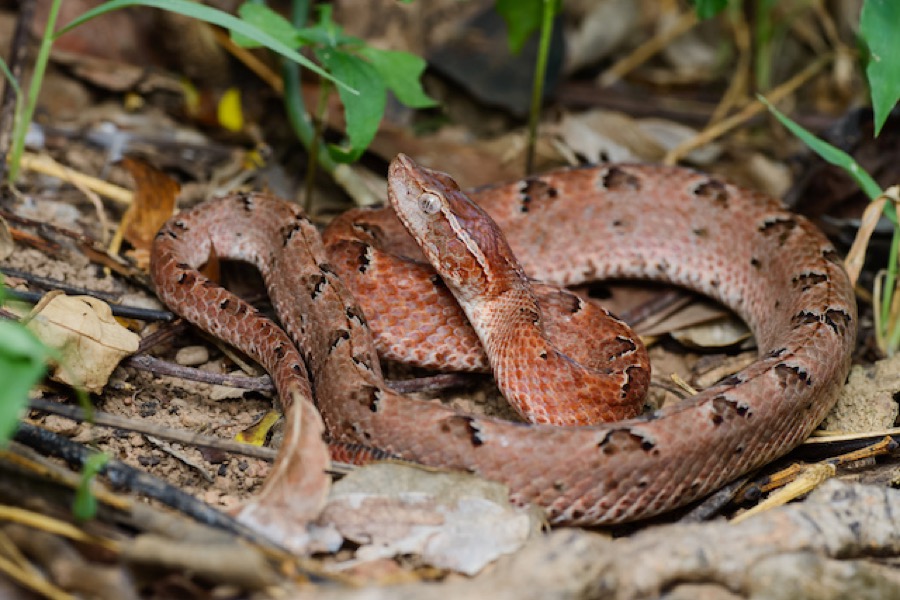
Its venom may cause local necrosis near the bite, even leading to loss of the affected limb if treatment is not begun soon enough. With hospital treatment, death is unlikely to occur.
Thousands of bites by this snake happen every year, many of them deadly. Most of the bites happen in rural areas to the people working in the forests or fields, where the snakes also wait for their prey.
Kraits
Four krait species are found in Thailand: Malayan (blue) krait and banded krait can be found in Hua Hin and all over the country, many-banded kraits live in the north and red-headed kraits in the south. All kraits have highly toxic venom, but fortunately they are not very aggressive. They have striking, bright coloration, serving as a warning of their toxicity, and making them easier to notice than some other snakes on this list.

Malayan krait: Pretty, but deadly. Thai National Parks
The Malayan krait, or blue krait (Bungarus candidus) is widespread throughout Thailand. Its venom is among the most potent of all land snakes - even with antivenom treatment, chances of survival are, at best, fifty-fifty.
Fortunately, this snake is not very aggressive and rarely bites unless seriously provoked. Easily recognizable by its black-and-white striped pattern.
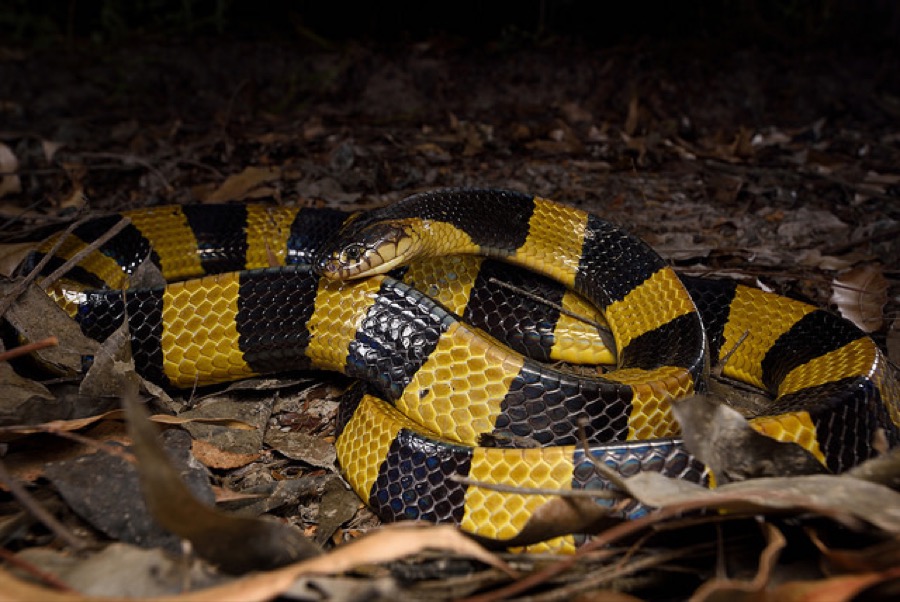
Like the blue krait, but yellow. Tontan Travel
Related to the above is the yellow-and-black banded krait (Bungarus fasciatus). Apart from its color, it’s quite similar to the blue krait in behavior and venom toxicity. This snake is easy to identify by its bright colors and the triangular cross-section of its body.
Cobras
I’m sure you have heard of cobras before. Thailand has four species of these hooded, venomous snakes: Siamese spitting cobra, Sumatran spitting cobra, monocled cobra and the famous king cobra. The Sumatran spitting cobra is only found in Southern Thailand, the rest are widespread around the country.
Cobras are often pictured with their head high and the distinctive hood spread wide open. This is their “warning” pose; when cobras feel threatened or angry, they adopt this pose to scare off any threats. Do be careful when you see a cobra like this - you can be sure it’s ready to strike in a split-second.
Contrary to popular belief, most cobras cannot spit their venom towards their target. Only the few spitting cobra species are capable of that, the rest rely on good old-fashioned biting to deliver their venom.
King cobra - majestic.
Tontan Travel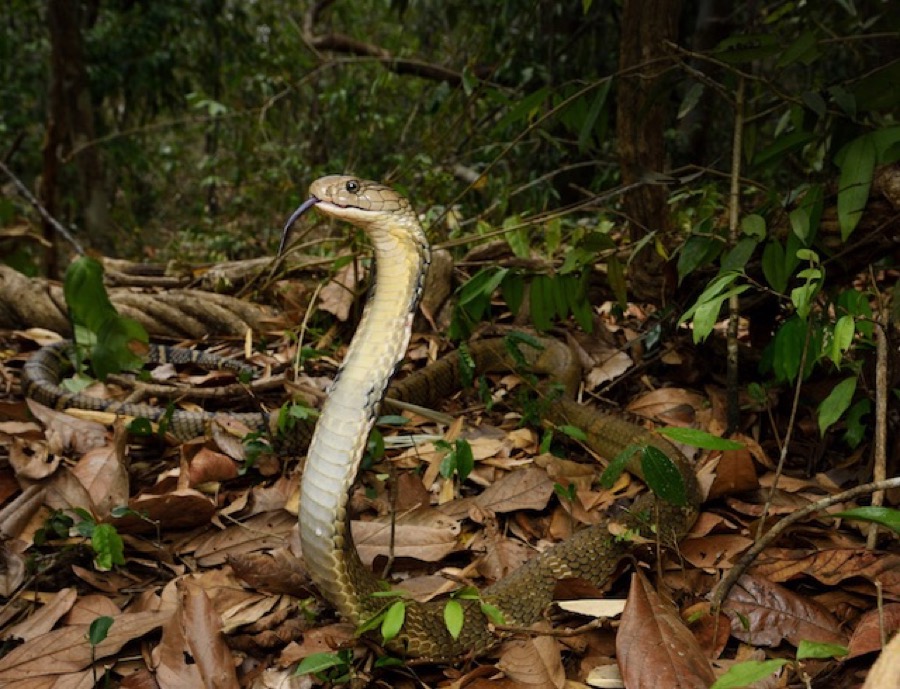
Usually not aggressive towards humans if not disturbed, but not very afraid of them either. Can strike very fast - keep your distance and let the snake have enough space around to slither away.
King cobra can be easily identified by its size and the chevron pattern on along its body. Clear chevron pattern on this baby king cobra. The pattern is usually darker on older individuals.
Wikimedia Commons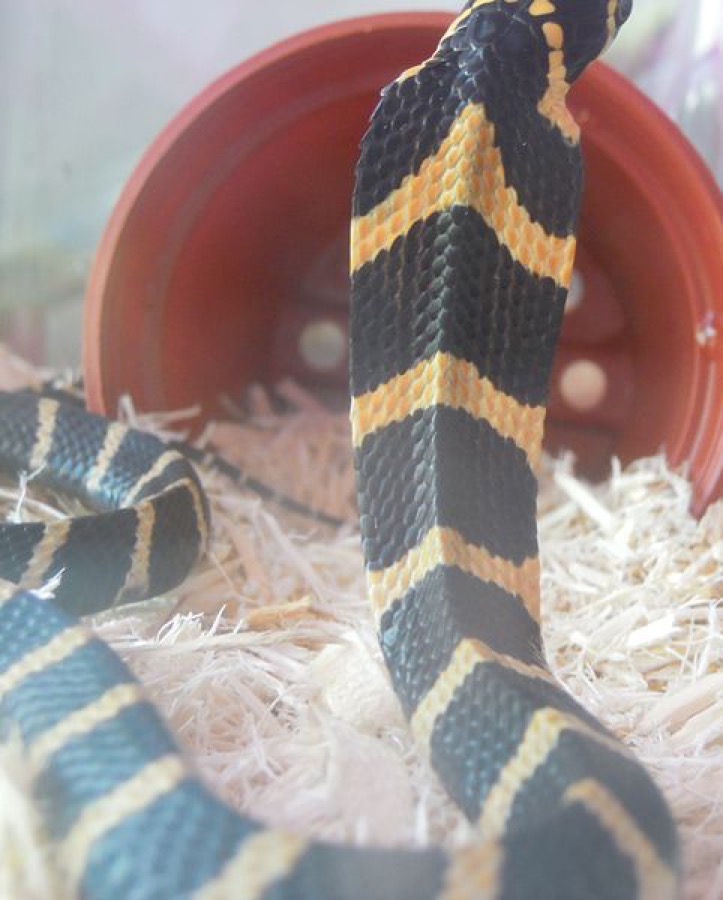
Monocled cobra, the most common cobra. Dangerous.
Tontan Travel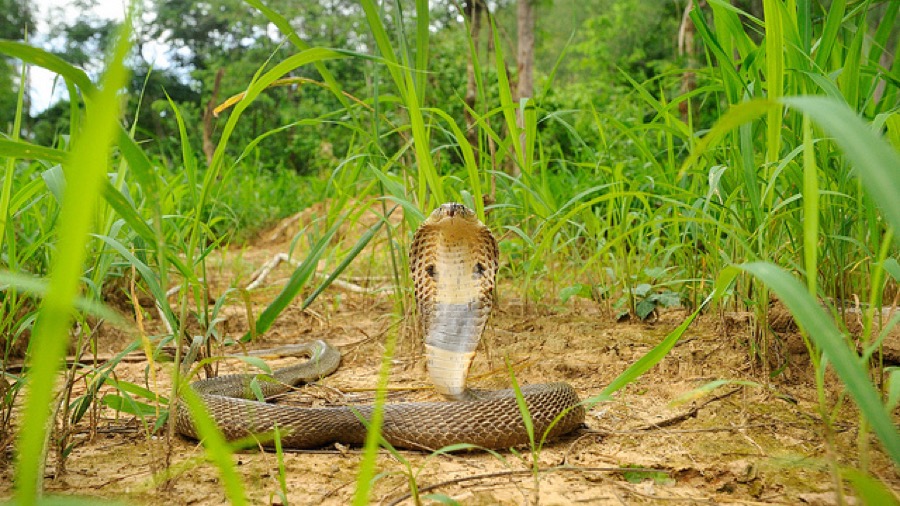
Monocled cobra gets its name from the round pattern on the back of its head, resembling a monocle. This serves as a clear identification of the species. Monocled cobra neck pattern.
Wikimedia Commons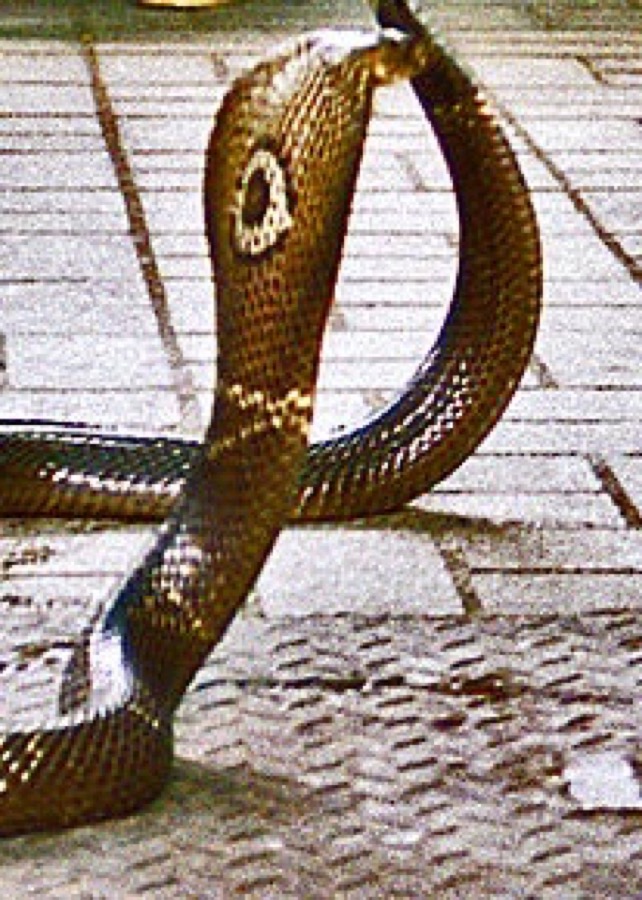
Careful, it may spit!
Tontan Travel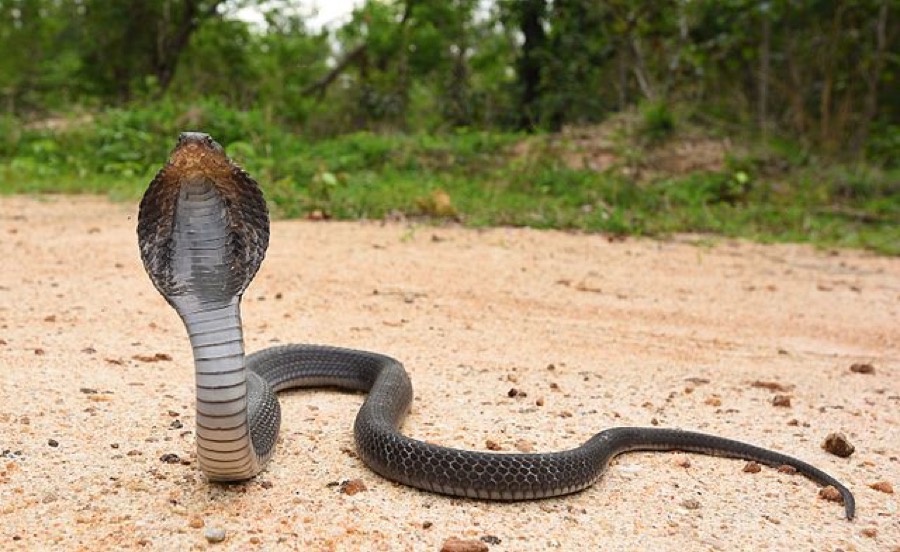
It presents an additional danger: the ability to spit its venom towards anything it deems a threat. It can spit its venom from more than 2 meters away, with deadly accuracy. If the venom hits your eyes, you can expect serious pain and at least temporary blindness - if it hits an open wound, you can expect envenomation and death.
Non-venomous snakes
These snakes are either completely non-venomous, or have only mild venom incapable of harming a human. That doesn’t make them completely harmless, though - all snakes can still bite if threatened, and the bite may get infected or at least hurt. It is advisable to visit a doctor if bitten by any snake.
Cute, big-headed whip. Harmless.
Wikimedia Commons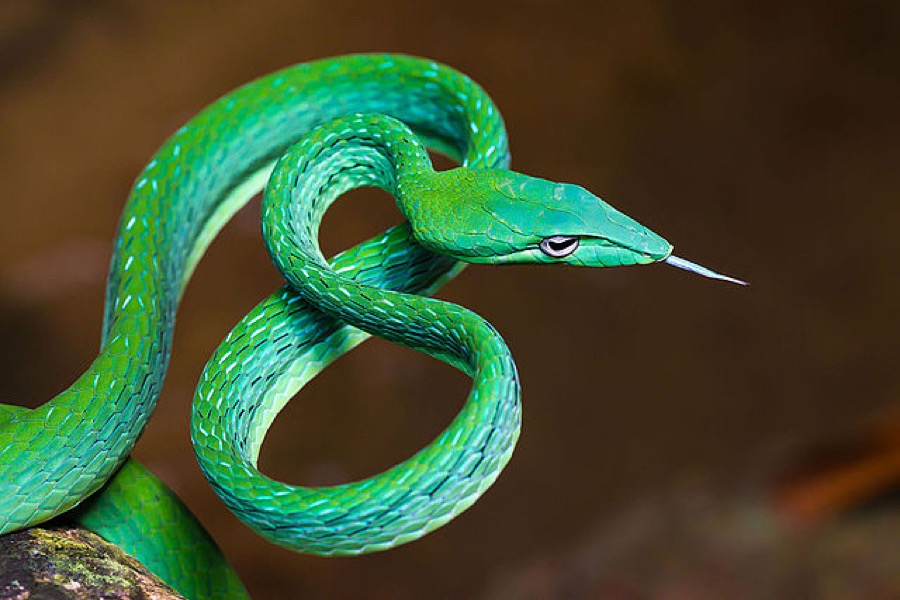
These are common all around Thailand. They are mildly venomous, but their bite is considered harmless for humans. They are very unlikely to bite you, though, due to their nonaggressive, calm nature. If, against all odds, they do happen to bite you it’s advisable to visit a doctor, as with any snakebite.
Not to be confused with brown vipers.
Wikimedia Commons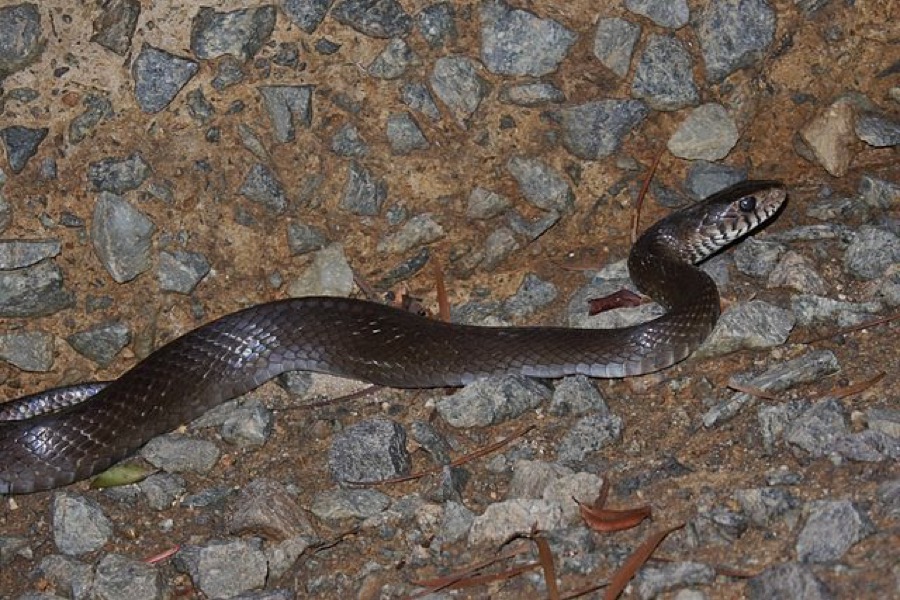
Due to its coloration, it may be sometimes confused with the dangerous vipers (see above). It can be distinguished by its size and especially the shape of its head: vipers have triangular heads, while rat snake’s heads are sleek and round.
When I grow up, I will eat so many pigs.
Thai National Parks
It is not considered to be dangerous to humans, but is certainly capable of seriously injuring or even killing an adult human. Its strong jaws can deliver a powerful bite, and it can easily strike head-high. Thus, disturbing or harassing this snake can be considered a very stupid thing to do, despite it being non-venomous.
Final words
The above has covered just a few of the snakes you can find in Thailand. Even just the Hua Hin area has more to offer for the aspiring amateur herpetologist.
And to summarize “snake safety”, just remember these simple rules:
- Don’t touch the snake, or try to catch it yourself
- Keep your distance
- Let it slither away
That will keep you safe in 99.9% of all your snake encounters. Remember, snakes will not strike you if they don’t feel threatened.
And finally, here are some resources for those of you who just got interested in snakes and wish to learn more:
Thailand Snakes, a site by Vern Lovic, mentioned earlier. Great site with tons of info about snakes native to Thailand, what to do if you get bitten, and where to find the snakes. He also gives “herping tours” and courses about handling snakes.
Herping Thailand, another great site about Thailand’s snakes. They specialize in herping tours for snake enthusiasts.
Thai National Parks maintains a database of information about nature and wildlife of Thailand. Great resource.
And of course, there’s always Wikipedia, although I’ve found some of the articles on that list a bit thin.